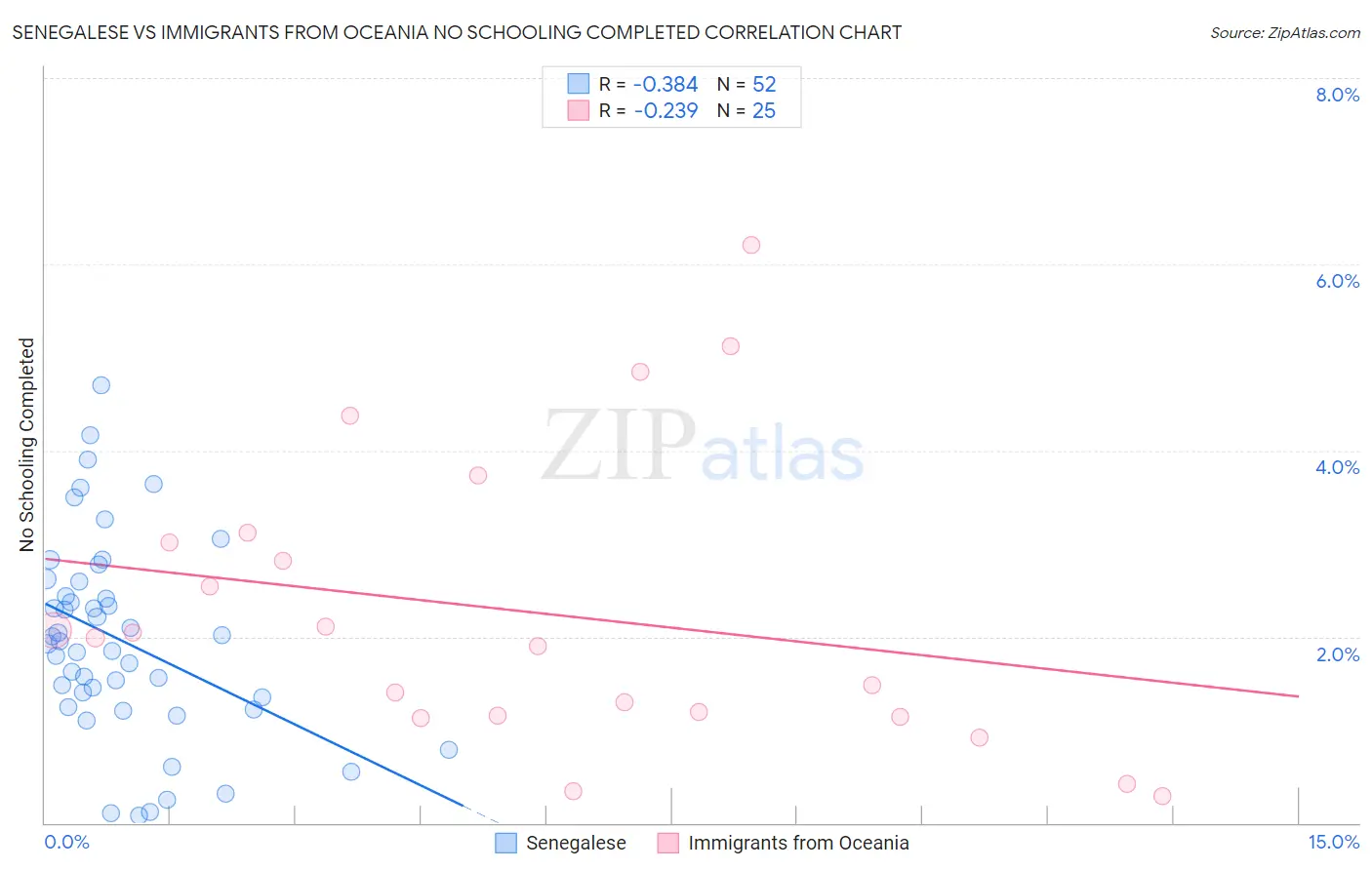Senegalese vs Immigrants from Oceania No Schooling Completed
COMPARE
Senegalese
Immigrants from Oceania
No Schooling Completed
No Schooling Completed Comparison
Senegalese
Immigrants from Oceania
2.3%
NO SCHOOLING COMPLETED
5.6/ 100
METRIC RATING
219th/ 347
METRIC RANK
2.2%
NO SCHOOLING COMPLETED
10.2/ 100
METRIC RATING
209th/ 347
METRIC RANK
Senegalese vs Immigrants from Oceania No Schooling Completed Correlation Chart
The statistical analysis conducted on geographies consisting of 78,004,771 people shows a mild negative correlation between the proportion of Senegalese and percentage of population with no schooling in the United States with a correlation coefficient (R) of -0.384 and weighted average of 2.3%. Similarly, the statistical analysis conducted on geographies consisting of 302,492,399 people shows a weak negative correlation between the proportion of Immigrants from Oceania and percentage of population with no schooling in the United States with a correlation coefficient (R) of -0.239 and weighted average of 2.2%, a difference of 2.0%.

No Schooling Completed Correlation Summary
| Measurement | Senegalese | Immigrants from Oceania |
| Minimum | 0.075% | 0.28% |
| Maximum | 4.7% | 6.2% |
| Range | 4.6% | 5.9% |
| Mean | 2.0% | 2.3% |
| Median | 1.9% | 2.0% |
| Interquartile 25% (IQ1) | 1.3% | 1.1% |
| Interquartile 75% (IQ3) | 2.5% | 3.1% |
| Interquartile Range (IQR) | 1.2% | 1.9% |
| Standard Deviation (Sample) | 1.1% | 1.6% |
| Standard Deviation (Population) | 1.0% | 1.5% |
Demographics Similar to Senegalese and Immigrants from Oceania by No Schooling Completed
In terms of no schooling completed, the demographic groups most similar to Senegalese are Immigrants from Costa Rica (2.3%, a difference of 0.26%), Immigrants from Sudan (2.3%, a difference of 0.35%), Immigrants from Nepal (2.3%, a difference of 0.44%), Subsaharan African (2.3%, a difference of 0.53%), and Immigrants from Syria (2.3%, a difference of 0.55%). Similarly, the demographic groups most similar to Immigrants from Oceania are Native/Alaskan (2.2%, a difference of 0.070%), Uruguayan (2.2%, a difference of 0.25%), South American Indian (2.2%, a difference of 0.26%), Bahamian (2.2%, a difference of 0.44%), and Immigrants from Bahamas (2.2%, a difference of 0.45%).
| Demographics | Rating | Rank | No Schooling Completed |
| Hopi | 12.9 /100 | #204 | Poor 2.2% |
| Immigrants | Bahamas | 11.6 /100 | #205 | Poor 2.2% |
| Bahamians | 11.6 /100 | #206 | Poor 2.2% |
| South American Indians | 11.0 /100 | #207 | Poor 2.2% |
| Uruguayans | 11.0 /100 | #208 | Poor 2.2% |
| Immigrants | Oceania | 10.2 /100 | #209 | Poor 2.2% |
| Natives/Alaskans | 10.0 /100 | #210 | Tragic 2.2% |
| Immigrants | Panama | 8.8 /100 | #211 | Tragic 2.3% |
| Immigrants | Morocco | 8.7 /100 | #212 | Tragic 2.3% |
| Ute | 8.2 /100 | #213 | Tragic 2.3% |
| Samoans | 8.2 /100 | #214 | Tragic 2.3% |
| Immigrants | Zaire | 7.2 /100 | #215 | Tragic 2.3% |
| Tongans | 6.8 /100 | #216 | Tragic 2.3% |
| Immigrants | Syria | 6.6 /100 | #217 | Tragic 2.3% |
| Immigrants | Nepal | 6.4 /100 | #218 | Tragic 2.3% |
| Senegalese | 5.6 /100 | #219 | Tragic 2.3% |
| Immigrants | Costa Rica | 5.1 /100 | #220 | Tragic 2.3% |
| Immigrants | Sudan | 5.0 /100 | #221 | Tragic 2.3% |
| Sub-Saharan Africans | 4.7 /100 | #222 | Tragic 2.3% |
| Immigrants | Lebanon | 4.5 /100 | #223 | Tragic 2.3% |
| Tohono O'odham | 4.1 /100 | #224 | Tragic 2.3% |